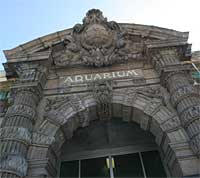|
FOBIA
Friends of Belle Isle Aquarium
An institution founders.
Aquarium may be sunk;
its allies fish for solutions
by
Nancy Kaffer - Metro Times staff writer

It seems likely that by this time next
month, the Belle Isle Aquarium will be closed. With a $230 million
deficit looming, Detroit city administrators are looking to cut costs,
with major cuts to city bus routes and large-scale layoffs first on the
list — and a 101-year-old aquarium facing declining attendance and
needing major repairs can’t be far behind.
 |
| Kathy Smith
takes what may be a last look at a finned friend.
|
Detroit Zoological Institute Director Ron Kagan says he was originally
told he’d have to pare $2.2 million from the budget of the institution,
which administers the zoo. Though the city now only demands a reduction
of about $1 million, the aquarium — included in the zoo’s budget — was a
natural target for the cut, though Kagan wouldn’t say whether city or
zoo officials initially proposed putting the Belle Isle Aquarium on the
chopping block.
A report released by the institute says attendance has plummeted from
113,000 in 1995 to 56,000 in 2004. With about $489,000 in operating
expenses, the aquarium only brought in about $155,000 last year,
according to the city budget. But Kagan says falling attendance isn’t
the aquarium’s biggest problem.
ADVERTISEMENT
The Ark
“No matter who has it, it needs a lot more money,” Kagan says.
Complaints about the impending closure have put institute officials on
the defensive. “People keep saying we’re abandoning Belle Isle,” Kagan
says. “A lot of people opposed to this are hobbyists who don’t live in
the city, and the taxpayers are handling the costs of keeping it open.”
Kagan says the city spent about $600,000 three years ago fixing problems
with the aquarium’s floor, and that the aquarium still needs extensive
work to remain safe for humans or animals. He adds that there are no
assessments of what it would cost to bring the building up to date.
“It’s a beautiful building,” Kagan says, “but it’s 100 years old. One
hundred years ago, it was the best design possible for an aquarium.
There aren’t very many 100-year-old products in today’s society that
work.”
That, say Friends of the Belle Isle Aquarium, is exactly why the
aquarium should be saved.
“Detroit cannot afford to lose any more cultural icons,” FOBIA member Al
Klopeman says. “Otherwise, we’re going to be left with bars and casinos.
That’s not enough to draw people to the city.”
Kagan says plans to save or revitalize the existing aquarium aren’t
practical, but that he hopes the building could be used as a museum in
the future.
He advocates the construction of a new, state-of-the-art aquarium on
Detroit’s riverfront, though no funding has been secured for such a
project.
“What a new aquarium will do is generate $100 million of economic impact
each year to the city. There are not many things that can do that,”
Kagan says.
FOBIA members, motivated by a projected closing date in early March, are
desperately trying to keep the facility’s doors open and its collection
intact, because once the fish collection is dismantled, says FOBIA
leader Stephen Goodfellow, it’s all over.
Kagan says the aquarium’s collection — which includes endangered fish
species, some of which are extinct in the wild — can be placed at other
zoos and aquariums.
Goodfellow, who runs the Web site for FOBIA (belleisleaquarium.org),
says he knows that the aquarium needs a plan for the future. But his
organization’s first priority is to stop the closure.
At a meeting last week, FOBIA members brainstormed about ways to fund
the aquarium. Corporate sponsorship and volunteer efforts topped the
list.
Almost as popular as proposing potential means of keeping the aquarium
open are suggesting the causes for its decline. Members have discussed
everything from Kagan having a personal vendetta against the aquarium to
city plans to make Belle Isle into a high-end condo development.
Goodfellow says members are prepared to take their case to the City
Council, the mayor’s office and the Michigan Legislature, if that’s what
it takes to keep the aquarium from being shuttered.
“This is quality of life we’re talking about,” Goodfellow says. “If
there are no institutions that give us joy and hope, what shows us we
have a heritage?”
Kagan says money is the only thing that can save the Belle Isle
Aquarium. “I think the whole issue is money. If they had the guarantee
of a half-million or more for the next couple of years, and a couple of
million for repairs …”
Recent cuts in state funding to the Zoological Institute have also hurt
the aquarium. The zoo, including the Belle Isle facilities, has an
operating budget of about $11 million, Kagan says. About $600,000 comes
from the state, and the rest is made up of city support and earned
revenues from admissions and parking. The state funding has been cut
drastically in the last year.
The Detroit Zoological Society, from which Kagan was recently dismissed
as CEO, raises funds for the Zoological Institute. Kagan says he’ll stay
with the Society as a consultant, his original role with the group.
Society chairwoman Ruth Glancy declined to be interviewed, saying she
preferred Zoological Institute officials to discuss all topics relating
to the aquarium closure.
The aquarium isn’t the only victim in the zoo system, though it’s the
hardest hit. A total of 15 positions will be eliminated from the zoo
budget, Kagan says. He wasn’t sure how many of the aquarium’s six
employees would be reassigned to other jobs in the zoo and how many
would be laid off.
To make up the rest of the shortfall, Kagan says, the zoo is introducing
a new merchandise line that’s expected to bring in about $350,000 in
revenue in the next year. But that’s not an option for the aquarium,
according to a statement released by the zoo, which says the size and
layout of the aquarium make the addition of merchandise or concessions
impractical.
The problems with the aquarium are symptomatic of larger problems with
Belle Isle, and with many more city facilities, says Jason Booza, of
Wayne State’s Center for Urban Studies.
“It’s the same problem the Police Department is having — pumping money
into facilities so old that you’re wasting money trying to keep them
afloat,” Booza says.
Options could include turning the island over to the Huron-Clinton
Metropolitan Authority or charging a user fee for entrance to Belle
Isle.
“I don’t think there’s any solution that’s going to please everybody,”
Booza says. “What is the city going to do with Belle Isle as a whole?
It’s not the destination it once was. The aquarium seems to have been
one of those things — if you were going to Belle Isle, and the aquarium
just happened to be there, you would go to the zoo and go over to the
aquarium. The city needs a better plan for Belle Isle.”
Nancy Kaffer is a Metro Times staff writer. Send comments to
nkaffer@metrotimes.com
|


